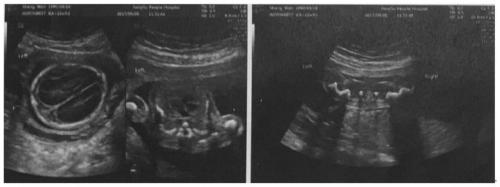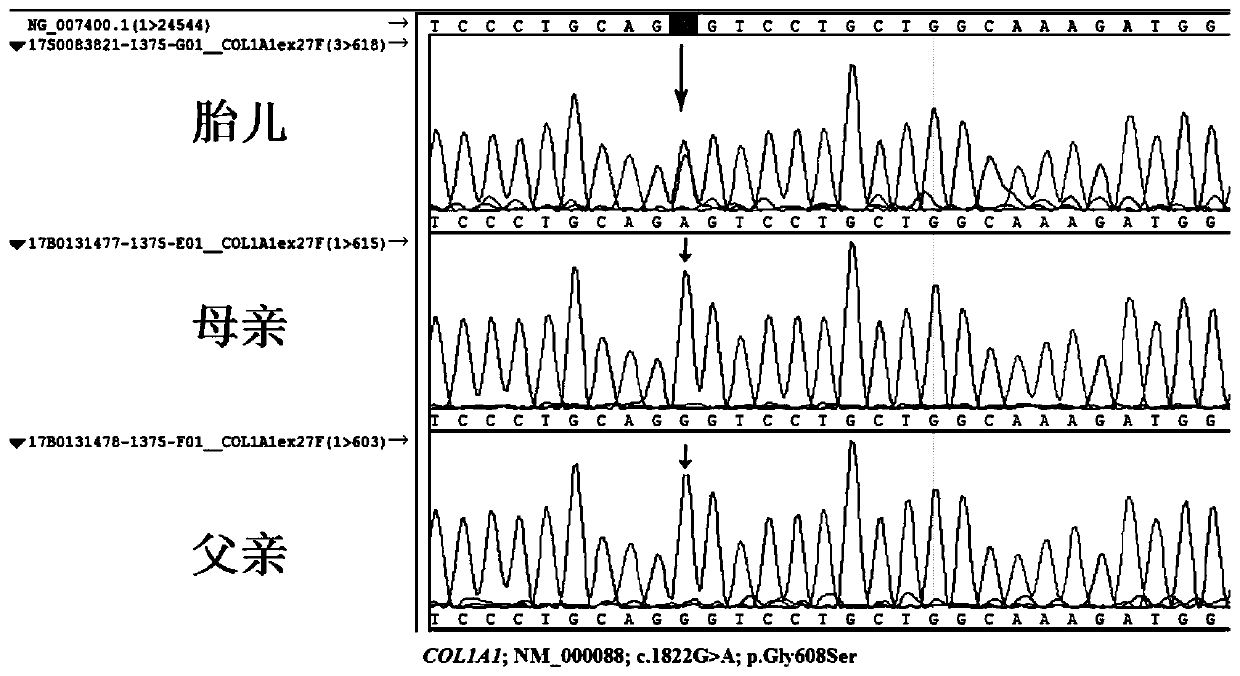Pathogenic mutation of osteogenesis imperfecta disease and detection reagent of pathogenic mutation
A hypoplasia and osteogenesis technology, applied in the field of biomedicine, can solve the problems of not being able to locate the disease-causing site, OI has not been reported, and screening out the disease-causing gene, etc.
- Summary
- Abstract
- Description
- Claims
- Application Information
AI Technical Summary
Problems solved by technology
Method used
Image
Examples
Embodiment 1
[0051] Genetic testing of a fetus with abnormal skeletal development on ultrasound.
[0052] experimental method:
[0053] 1. Collection of serial ultrasound results of pregnant women, and collection of case data such as family genetic history: collect clinical data and blood samples of each member of the family, collect peripheral blood from the parents of the fetus, and puncture the umbilical cord blood of the pregnant woman to take the umbilical cord blood for the fetus. Get a genetic diagnosis. The blood genomic DNA of each member of the family was extracted with a blood genomic DNA extraction kit (Tiangen Biochemical Technology Co., Ltd.).
[0054] 2. Use high-throughput sequencing technology to mine the pathogenic mutations in this family: detect 61 genes related to abnormal bone development, first fragment the genomic DNA and carry out end-labeling, and perform liquid phase hybridization with the The DNA fragments in the region were enriched and then sequenced using s...
Embodiment 2
[0062] Carry out functional research and gene knockout animal model research on the disease-causing gene detected in Example 1. Here, the new mutation c.1822G>A detected in the COL1A1 gene is taken as an example.
[0063] experimental method:
[0064] 1. Conservative analysis: Evaluate the frequency of occurrence of this site in each database.
[0065] 2. Predict the pathogenicity of mutations based on SIFT and polyphen values.
[0066] 3. The animal model of gene knockout confirms that the mutation site is a disease-causing mutation site.
[0067] (1) Analyze the homologous gene and point mutation position of COL1A1 in zebrafish, and select the correct homologous gene in zebrafish for making point mutations; find a gene highly similar to the human COL1A1 gene on the ENSEMBL website, which is ENSDARG00000012405, and analyze Conservation of mutation positions, such as image 3 . The above comparison results show that this site is conserved in zebrafish genes, implying the i...
PUM
 Login to View More
Login to View More Abstract
Description
Claims
Application Information
 Login to View More
Login to View More - R&D
- Intellectual Property
- Life Sciences
- Materials
- Tech Scout
- Unparalleled Data Quality
- Higher Quality Content
- 60% Fewer Hallucinations
Browse by: Latest US Patents, China's latest patents, Technical Efficacy Thesaurus, Application Domain, Technology Topic, Popular Technical Reports.
© 2025 PatSnap. All rights reserved.Legal|Privacy policy|Modern Slavery Act Transparency Statement|Sitemap|About US| Contact US: help@patsnap.com



